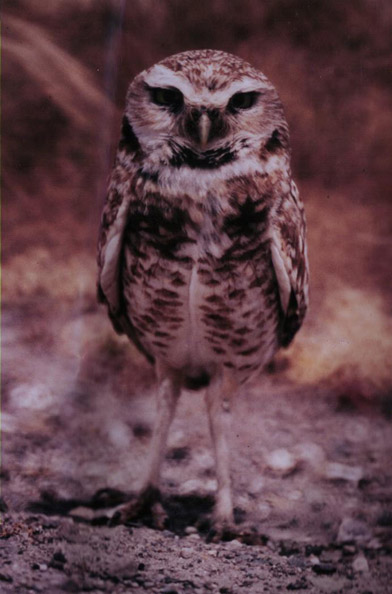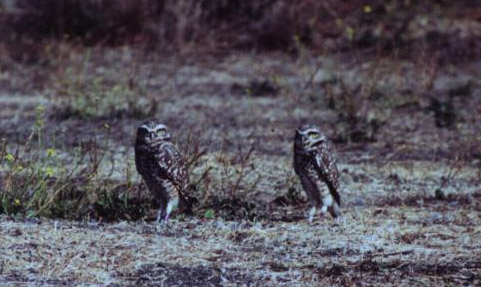|
Burrowing Owl Biology
|

|
Appearance
Common name: Western Burrowing Owl
Scientific name: Athene cunicularia which means little digger.
This is a slightly misleading name, as the burrowing owl very seldom
digs its own burrow but prefers to use the vacated burrows of small
mammals like prairie dogs and ground squirrels as is the case here
at Mission College.
Native to:
United States
Found: West of the Mississippi and also in southern Canada
and northern Mexico.
|
Endangered In:
Canada, Mexico, and in the US in the states of Minnesota and Iowa.
Designated as a "Species of Special Concern" in 6 other states
including California.
The burrowing owl is a small ground-dwelling raptor.
Height: Approximately 9 inches tall. | Weight: Up to 6 pounds.
They have a rounded head, lack ear tufts but are easily distinguishable
by their white eyebrows, bright yellow irises and long stilt like legs.
Their plumage is a mottled brown and white coloring. The female is slightly
smaller than the male and a little darker in coloring.
Burrowing Owls and
Ground Squirrels
They have a symbiotic relationship with ground squirrels, they take over
vacated squirrel burrows and live in the same colonies as the ground squirrels
but not in the same burrow. The ground squirrels gain an extra pair of
eyes to watch for predators from this relationship. The birds normally
have satellite burrows near the main burrow which are used to escape predators.
Special Traits:
- The Burrowing Owls are diurnal, meaning they're active
both day and night.
- Out of 171 species of owls worldwide, the Burrowing Owl
is the only one that live in burrows.
These birds can usually be seen standing at the entrance
to their burrows, they often like to stand perched on one leg only. They
are year round residents here at Mission College. Burrowing owls are found
in open prairie with few trees, they prefer the vegetation to be shorter
than they are, so they can see any predators approaching.
Diet
Burrowing owls are opportunistic feeders.
Diet includes:
- small rodents such as mice, voles
and shrews
- reptiles like frogs and lizards (we've
seen remains of frogs outside of a few of the burrows at Mission College;
most likely feeding at the Calabasas Creek.)
- the vast majority of their diet includes
insects especially Jerusalem crickets and earwigs.
Burrowing owls hunt by running rapidly
along the ground and catching their prey or by hovering above prey and
pouncing downwards. The owls at Mission College have been observed perching
on lamp posts at night and feasting on the insects that are attracted
to the light.
Breeding

The breeding season for burrowing owls starts in February when pairs will
bond together and search for an appropriate burrow. Egg laying begins
in March and a female can lay as many as 6 - 12 eggs although the success
rate for survival is much lower. Both parents feed the young and by September
the young will have fledged.
Courtship at Mission College
We observed a pair on campus during February 2000, during a courtship
display. They had chosen to set up home at an artificial mound consisting
of 6 burrows. The male and female were located at the entrance to 2 separate
burrows when the male flew over to a nearby post on a fence. The female
immediately flew to the adjacent post whereby both birds began preening
themselves while facing each other. Then the male returned to his original
location at the entrance to his burrow and the female returned to hers.
Then the male flew to a third burrow carrying something in its beak, it
faced the entrance to the burrow opened it wings fully, bobbed up and
down then entered the burrow. The female immediately followed suit and
both birds remained inside for approximately 6 minutes. Then both birds
returned to their original burrows.
|